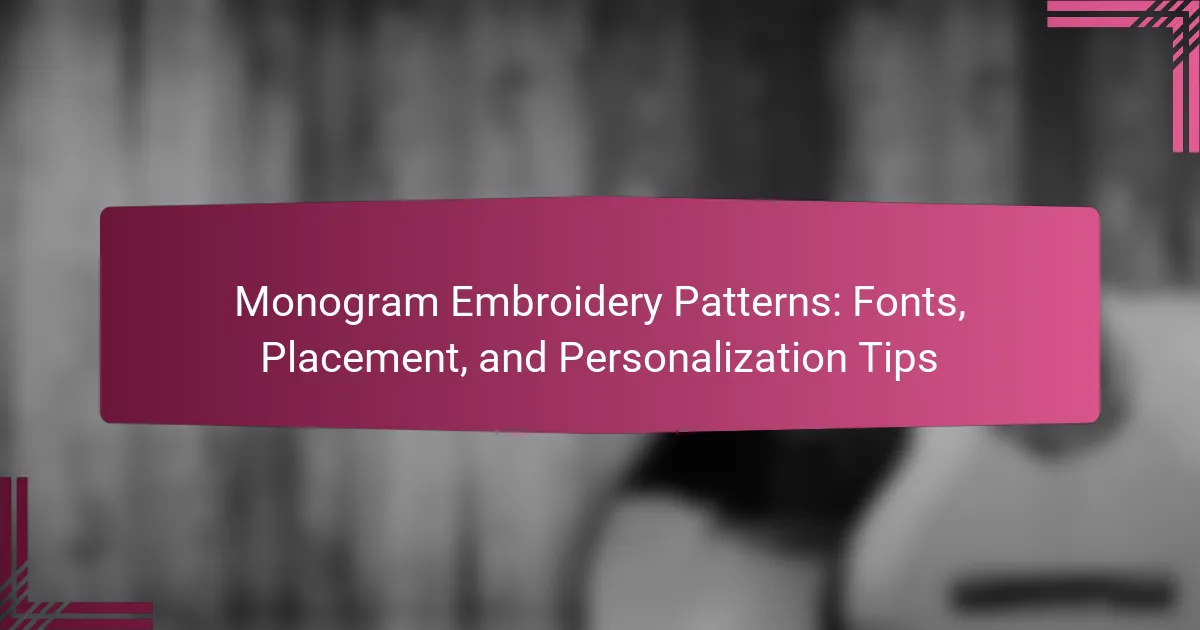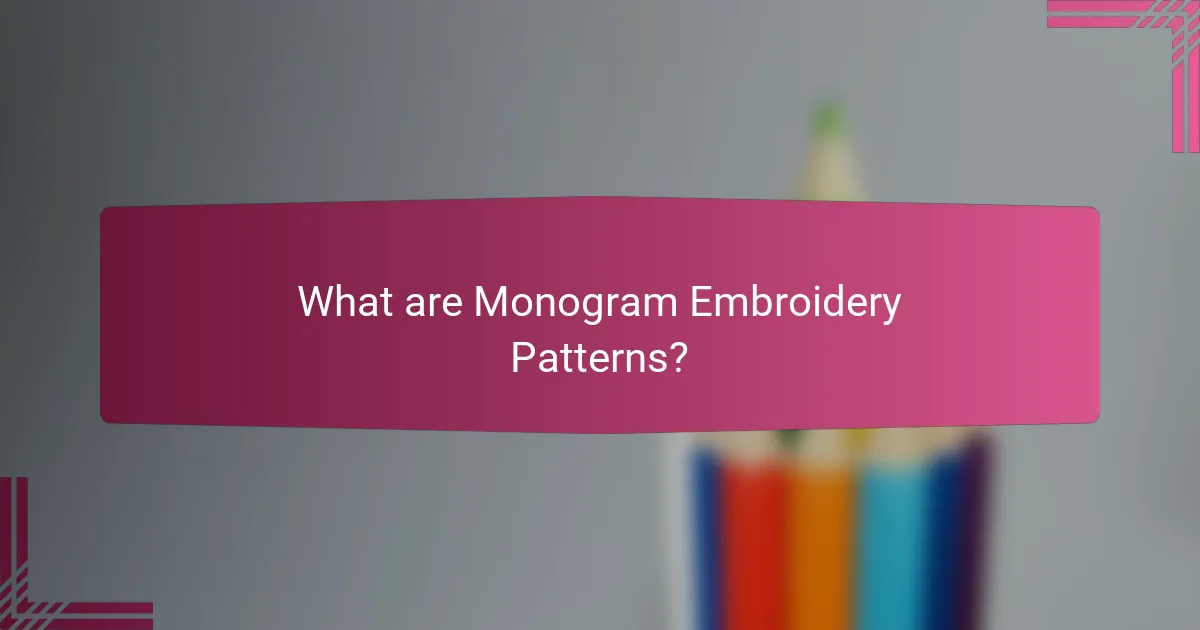
What are Monogram Embroidery Patterns?
Monogram embroidery patterns are designs that feature initials or letters, typically representing a person’s name. These patterns can be customized in various fonts and styles. They are popular for personalizing items like clothing, towels, and home decor. Monograms often consist of one, two, or three letters, arranged in a specific order. The first letter usually represents the last name, while the other letters represent the first and middle names. This tradition dates back to ancient times when monograms were used as a signature. Monogram embroidery patterns can be created using different stitching techniques, such as satin stitch or chain stitch. The versatility of these patterns allows for creative expression in personalization.
How are Monogram Embroidery Patterns created?
Monogram embroidery patterns are created through a combination of design software and embroidery machines. First, the desired monogram design is selected or created using graphic design software. This software allows for customization of fonts, sizes, and styles. Next, the design is converted into a digital embroidery file format compatible with the embroidery machine. The machine reads this file to stitch the design onto the chosen fabric. The process involves selecting thread colors and adjusting machine settings for optimal stitching. Finally, the embroidery machine executes the design, resulting in a finished monogram pattern.
What tools and materials are needed for Monogram Embroidery?
Monogram embroidery requires specific tools and materials. Essential tools include an embroidery machine or a hoop for hand embroidery. You will need embroidery thread in various colors. A needle suitable for embroidery is also necessary. Fabric, such as cotton or linen, serves as the base for the monogram. Stabilizers help maintain fabric stability during stitching. Scissors for trimming threads are important. Lastly, a design software may assist in creating custom monogram designs. These tools and materials collectively enable effective monogram embroidery.
What techniques are commonly used in Monogram Embroidery?
Common techniques used in monogram embroidery include satin stitch, chain stitch, and backstitch. Satin stitch creates a smooth, shiny finish ideal for letters. Chain stitch offers a textured look, adding dimension to the design. Backstitch is often used for outlining letters and provides a clean edge. Other techniques may include fill stitch for solid areas and decorative stitches for embellishment. These techniques are widely adopted in various embroidery projects to enhance visual appeal.
Why are Monogram Embroidery Patterns popular?
Monogram embroidery patterns are popular due to their personalization and uniqueness. They allow individuals to express their identity through initials. This form of embroidery has historical significance, often used for marking personal belongings. Monograms are versatile, suitable for various items like towels, bags, and clothing. Their aesthetic appeal enhances the visual interest of everyday objects. Customization options, including font styles and thread colors, add to their popularity. The trend of personalized gifts has increased demand for monogrammed items. Surveys indicate that personalized products are preferred by consumers for gifting.
What occasions are best suited for Monogram Embroidery?
Monogram embroidery is best suited for occasions such as weddings, anniversaries, and baby showers. These events often celebrate personal milestones and relationships. Monogramming adds a personalized touch to gifts and décor. It enhances items like towels, robes, and linens. Monogrammed gifts are memorable and unique. They signify thoughtfulness and care in gift-giving. Additionally, monograms are popular for corporate events and branding. They can elevate company merchandise and promotional items.
How do Monograms enhance personalization in embroidery?
Monograms enhance personalization in embroidery by adding unique identifiers to items. They typically consist of initials, which represent an individual or family. This customization makes embroidered items more meaningful and special. Monograms allow for various font styles and placements, further enhancing their uniqueness. For example, different arrangements of initials can convey different styles or sentiments. Custom monogramming can also reflect personal tastes and preferences. This level of personalization increases the emotional value of the embroidered piece. Overall, monograms create a distinctive touch that sets items apart from generic embroidery.
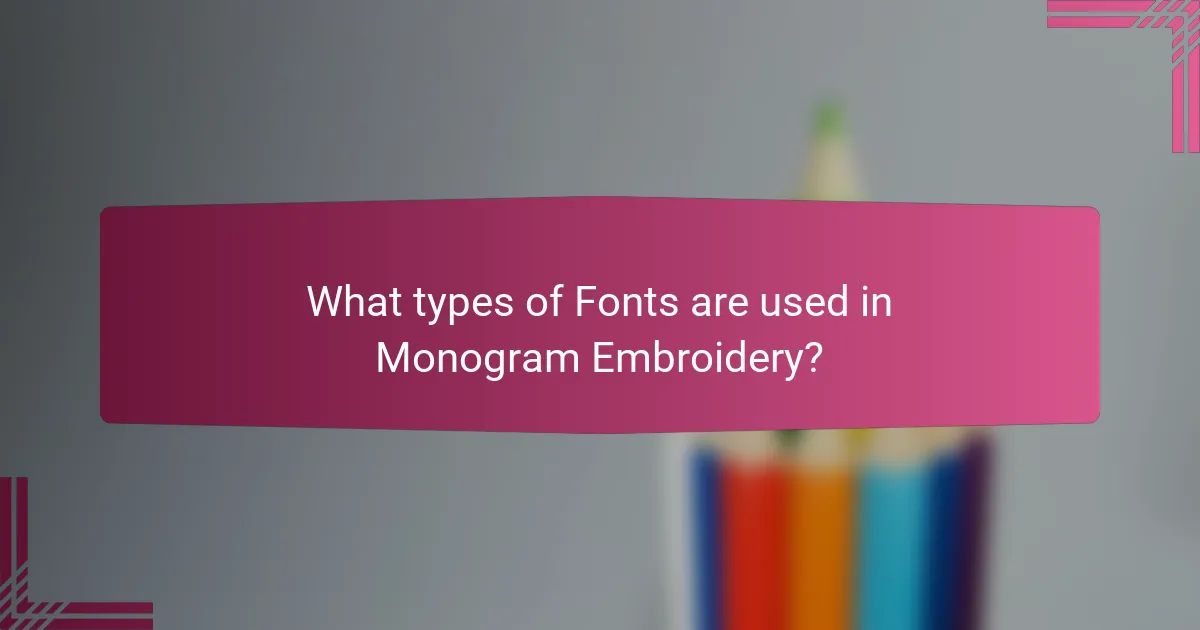
What types of Fonts are used in Monogram Embroidery?
Monogram embroidery commonly uses three types of fonts: serif, sans-serif, and script. Serif fonts feature small lines at the ends of characters, providing a classic look. Sans-serif fonts are clean and modern, lacking those lines, which makes them easy to read. Script fonts mimic handwriting, adding elegance and personalization to designs. Each font type can convey different styles and sentiments in monogram embroidery. For example, serif fonts often evoke tradition, while script fonts suggest formality or romance. The choice of font influences the overall aesthetic of the embroidered piece.
How do different Fonts affect the style of Monogram Embroidery?
Different fonts significantly impact the style of monogram embroidery. Fonts determine the overall aesthetic and readability of the monogram. For example, serif fonts convey elegance and tradition, making them suitable for formal occasions. Conversely, sans-serif fonts offer a modern and clean look, ideal for casual settings. Script fonts add a personal touch, enhancing the uniqueness of the piece. The choice of font also affects the size and spacing of the letters, influencing how the monogram fits into the design. Additionally, intricate fonts may require more careful stitching, affecting the durability of the embroidery. Ultimately, the selection of font can transform the character and impression of the monogram embroidery.
What are the most popular Font styles for Monograms?
The most popular font styles for monograms include serif, script, and sans-serif. Serif fonts, like Times New Roman, provide a classic and formal look. Script fonts, such as Brush Script, add elegance and a personal touch. Sans-serif fonts, like Arial, offer a modern and clean appearance. These styles are favored for their readability and aesthetic appeal in monogram designs. Many designers choose these fonts to enhance the visual impact of monograms on various items, from clothing to home decor.
How can Font choice impact readability in Monogram Embroidery?
Font choice significantly impacts readability in monogram embroidery. The clarity of letters affects how easily the text can be read. Fonts with simple, clean lines enhance legibility. In contrast, overly decorative fonts may obscure letters, making them hard to decipher.
Research indicates that sans-serif fonts are often more readable than serif fonts in small sizes. Monogram embroidery typically involves smaller text, emphasizing the need for clear font selection. Additionally, the thickness of the font strokes can influence visibility. Thicker letters may stand out better on fabric.
Color contrast between the thread and fabric also plays a crucial role. High contrast can improve readability, while low contrast may hinder it. Thus, choosing the right font is essential for ensuring that monograms are easily readable.
What factors should be considered when choosing Fonts for Monograms?
When choosing fonts for monograms, consider legibility, style, and personalization. Legibility ensures that the monogram is easily readable at various sizes. Styles should align with the intended aesthetic, whether classic, modern, or whimsical. Personalization allows for unique expressions, such as incorporating initials or symbols. Additionally, consider the medium of embroidery, as some fonts may not translate well to fabric. Font weight and spacing affect the overall appearance and balance of the monogram. Test different fonts to see how they interact with the design elements.
How do personal preferences influence Font selection?
Personal preferences significantly influence font selection in design. Individuals often choose fonts based on their aesthetic appeal and emotional resonance. For instance, a playful font may evoke a sense of fun, while a serif font may convey tradition and reliability. Research indicates that font choice can impact readability and viewer perception. According to a study by McCarthy et al. (2017), fonts that align with personal taste enhance engagement and satisfaction. Thus, personal preferences guide font selection to create desired emotional responses in monogram embroidery patterns.
What role does the fabric type play in Font choice?
Fabric type significantly influences font choice in monogram embroidery. Different fabrics have varying textures and weights. Heavier fabrics can support bolder, thicker fonts, while lighter fabrics may require finer, more delicate fonts. The fabric’s texture affects legibility and overall aesthetic. For example, a plush fabric might obscure intricate font details. Conversely, smooth fabrics can showcase detailed fonts effectively. Choosing the right font for the fabric ensures clarity and visual appeal. Therefore, understanding fabric characteristics is crucial for optimal font selection in embroidery projects.
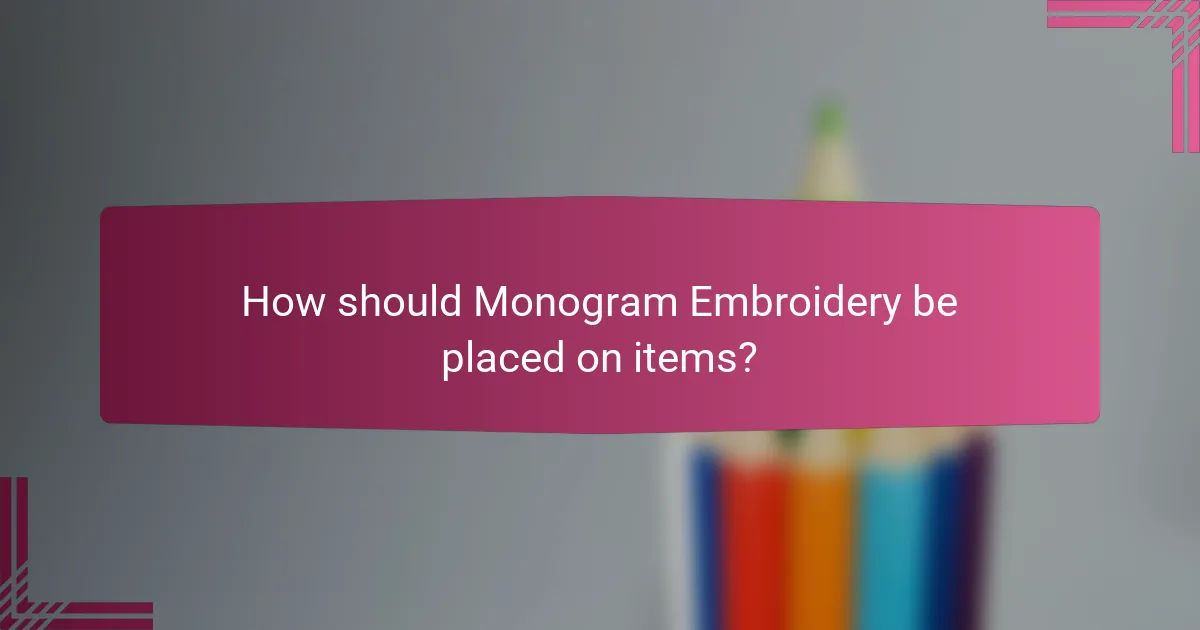
How should Monogram Embroidery be placed on items?
Monogram embroidery should be placed in a way that enhances the item’s aesthetic and functionality. Common placements include the upper left chest area for shirts and blouses. For towels, the center or corner is preferred. On bags, the front or side is ideal. Placement should consider the item’s size and shape. For larger items, such as blankets, the center is often best. The style of the item can also influence placement decisions. Traditional items may suit classic placements, while modern designs allow for more creativity. Consistency in placement across similar items can create a cohesive look.
What are the best practices for placement of Monograms?
Monogram placement should be strategic for optimal visual impact. Common placements include the upper left chest area on shirts and jackets. Centered placement works well on bags and towels. For formal items, consider the bottom right corner for a subtle touch. The size of the monogram should be proportionate to the item. For example, larger items can accommodate bigger monograms. Ensure the font style aligns with the item’s purpose. Script fonts are often used for formal occasions, while block fonts suit casual items. Consistency in placement across similar items enhances a cohesive look.
How does item shape influence Monogram placement?
Item shape significantly influences monogram placement. Different shapes require specific positioning for aesthetic balance. For instance, round items like mugs typically feature monograms centered on the front. Square or rectangular items, such as bags, often place monograms in a corner or along a seam. The curvature of an item can dictate the size and orientation of the monogram. A flatter surface allows for larger designs, while curved surfaces may necessitate smaller, more compact placements. These considerations ensure the monogram complements the overall design without overwhelming the item’s shape.
What are common placement locations for different items?
Common placement locations for monogram embroidery include the top left chest area on shirts, the center of towels, and the bottom right corner of bags. Shirts often feature monograms on the left chest for visibility and personalization. Towels typically showcase monograms in the center for aesthetic appeal. Bags usually have monograms placed in the bottom right for a subtle yet stylish touch. These placements enhance the item’s aesthetic while maintaining functionality.
Why is placement important in Monogram Embroidery?
Placement is important in monogram embroidery because it affects the overall aesthetic and readability of the design. Proper placement ensures that the monogram is visually balanced and harmonizes with the item being embroidered. For instance, placing a monogram too high or too low can make it appear awkward or disproportionate. Additionally, correct placement enhances the personalization aspect, making the item feel unique and tailored. Studies show that well-placed embroidery can increase the perceived value of an item, as it reflects attention to detail. Therefore, careful consideration of placement is crucial for achieving a polished and professional look in monogram embroidery.
How can placement affect the overall design aesthetic?
Placement significantly influences the overall design aesthetic by determining visual balance and focal points. Strategic placement can enhance the visibility of design elements. For example, centering a monogram on a garment draws immediate attention. Conversely, off-center placements can create a dynamic and modern look. The relationship between elements is also affected by placement; it can either harmonize or create tension. Research shows that well-placed designs improve user engagement and satisfaction. Effective placement aligns with the principles of design, such as contrast and alignment, which are essential for a cohesive aesthetic.
What are the implications of placement on visibility and use?
Placement significantly affects the visibility and use of monogram embroidery patterns. Proper placement enhances the aesthetic appeal and legibility of the design. For instance, positioning a monogram at the center of a garment increases its prominence. Conversely, placing it too low or too high may diminish its visibility. Research indicates that the average viewer’s eye is naturally drawn to the center of a design. Thus, optimal placement can improve user engagement and satisfaction. Additionally, placement impacts the functionality of the item. If a monogram obstructs seams or fasteners, it may hinder the use of the garment. Therefore, thoughtful placement is crucial for both visual impact and practical usability.
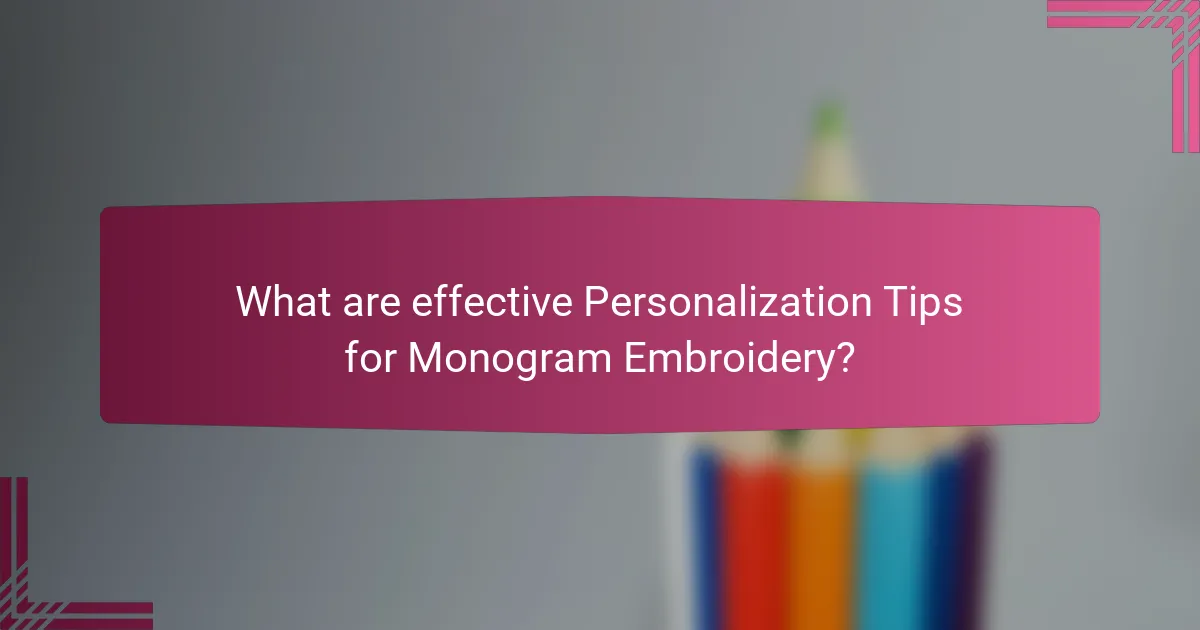
What are effective Personalization Tips for Monogram Embroidery?
Effective personalization tips for monogram embroidery include selecting meaningful initials, choosing complementary colors, and considering font styles. Initials should represent the recipient’s name or significant dates. Colors should match the fabric and reflect personal preferences. Font styles can range from elegant scripts to bold block letters, depending on the overall design. Additionally, placement of the monogram is crucial; common locations include the corner of a handkerchief or the chest area of a shirt. Customizing the size of the monogram can also enhance its visibility and impact. Finally, incorporating decorative elements like borders or icons can add a unique touch.
How can you personalize Monogram Embroidery for gifts?
You can personalize monogram embroidery for gifts by selecting initials that represent the recipient. Choose a font style that matches their personality or the occasion. Consider the placement of the monogram on the item, such as the center or corner. Incorporate additional elements like symbols or dates to enhance the design. Use color schemes that align with the recipient’s preferences. Customizing the size of the monogram can also add a unique touch. Each of these choices creates a meaningful and personalized gift.
What initials or symbols are commonly used in personalization?
Common initials used in personalization include the letters of a person’s name, often in the form of monograms. Symbols like ampersands (&) are also popular for representing partnerships or relationships. For example, a typical monogram for an individual might use the first, last, and middle initials in that order. Couples often use their initials combined with an ampersand to signify unity. The use of initials and symbols in personalization enhances the uniqueness of embroidered items. Monogramming is a traditional practice that dates back centuries, emphasizing individuality and ownership.
How do you incorporate personal stories into Monogram designs?
Personal stories can be incorporated into Monogram designs by using symbols or motifs that represent significant life events. For example, a couple’s initials can be combined with a symbol of their wedding date. This method adds personal significance to the design. You can also choose colors that reflect meaningful memories or experiences. Specific fonts can evoke emotions connected to personal stories. Including dates or locations in the design can further personalize the monogram. Each element should tell a part of the individual’s story. This approach creates a unique and meaningful piece of art. Personalization in monogram designs enhances emotional connection and value.
What are the common mistakes to avoid in Monogram Embroidery?
Common mistakes to avoid in monogram embroidery include incorrect font selection, improper placement, and inadequate thread tension. Choosing a font that is too intricate can lead to difficulty in readability. Placing the monogram in an unsuitable location may disrupt the design’s balance. Not adjusting thread tension can result in puckering or loose stitches. Using a fabric that is not compatible with embroidery can affect the final appearance. Failing to consider the size of the monogram in relation to the item can lead to disproportionate designs. Neglecting to test the design on a sample fabric can cause unexpected issues during the final application. Lastly, overlooking the importance of color contrast can diminish the monogram’s visibility.
How can you ensure correct spelling and format in Monograms?
To ensure correct spelling and format in monograms, start by confirming the initials to be used. Monograms typically consist of three initials: the first name, last name, and middle name. The last name initial is usually the largest and centered. Use a reliable font that clearly displays the letters. Double-check the spelling of each name before finalizing the design. Consistency in letter size and spacing is crucial for a polished look. Review examples of traditional monogram formats for guidance. Using software or templates can help maintain accuracy in design. Following these steps will help achieve a professional appearance in monogram embroidery.
What should you consider to avoid design overcrowding?
To avoid design overcrowding, prioritize simplicity in your monogram embroidery patterns. Limit the number of fonts used to one or two for cohesion. Ensure ample white space around the design elements to enhance visibility. Choose a clear and legible font style that complements the overall aesthetic. Avoid excessive embellishments that can distract from the main design. Consider the size and placement of the monogram to maintain balance. Use contrasting colors wisely to make the design pop without overwhelming it. These strategies help create a harmonious and appealing embroidery design.
What are some practical tips for successful Monogram Embroidery?
Choose the right fabric for monogram embroidery. Fabrics like cotton or linen work best. Use a stabilizer to prevent fabric distortion during stitching. A tear-away or cut-away stabilizer is recommended for most projects. Select appropriate thread colors that contrast with the fabric. This enhances visibility and aesthetics. Ensure the monogram font is legible and fits the design. Popular choices include serif and sans-serif fonts. Consider the placement of the monogram carefully. Common locations include the upper left chest or center of a towel. Test the design on scrap fabric before the final piece. This helps identify any issues with size or alignment. Finally, maintain consistent tension while embroidering. This ensures even stitching and a professional finish.
Monogram embroidery patterns are designs featuring initials or letters that personalize items such as clothing and home decor. The article explores the creation process of these patterns, including tools and techniques like satin stitch and chain stitch. It discusses the significance of font selection, placement strategies, and personalization tips to enhance the uniqueness of monograms. Additionally, the article highlights common mistakes to avoid and practical tips for successful embroidery, ensuring clarity and aesthetic appeal in the final designs.
